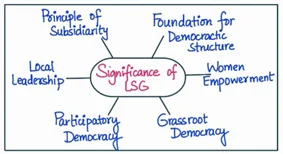Answer:
| Approach:
Introduction
- Briefly introduce the concept of local level government systems, Panchayats, and Samitis.
Body
- Discuss the role of education and organization in local governance, analyze the effectiveness of Panchayats and Samitis as instruments of governance, and critically discuss their limitations.
Conclusion
- Sum up the importance of strengthening local governance systems to ensure effective governance at the grassroots level.
|
Introduction:
Panchayats and Samitis are local level government institutions in India, established under the 73rd and 74th Constitutional Amendments to ensure decentralized governance and promote participatory democracy. These institutions aim to facilitate local self-governance, empower communities, and address the specific needs of rural and urban areas.
Body:
Role of education and organization in local governance:
- Capacity building: Education and organization are essential for capacity building of local representatives, enabling them to effectively carry out their responsibilities and address the needs of their communities.
- Decision-making: A well-educated and organized local governance system facilitates informed decision-making, leading to better policies and programs that cater to local needs.
- Accountability: Education and organization empower local representatives to hold higher authorities accountable and ensure that resources are utilized efficiently and transparently.

Effectiveness of Panchayats and Samitis as instruments of governance:
- Decentralization: Panchayats and Samitis have played a crucial role in decentralizing governance and bringing decision-making closer to the people, thus fostering a sense of ownership and participation among communities.
- Social inclusion: These institutions have provided a platform for marginalized communities, such as women and Scheduled Castes and Scheduled Tribes, to participate in local governance and voice their concerns.
- Local development: Panchayats and Samitis have been instrumental in planning and implementing local development projects, such as building roads, schools, and healthcare facilities, which cater to the specific needs of rural and urban areas.
Limitations and challenges:
- Lack of education and training: The absence of well-educated and trained local representatives hampers effective decision-making, policy formulation, and implementation.
- Inadequate resources: Limited financial and human resources at the local level often constrain the ability of Panchayats and Samitis to execute development projects and deliver public services effectively.
- Political interference: Panchayats and Samitis are sometimes influenced by state-level politics, which can compromise their autonomy and ability to function as effective instruments of governance.
- Bureaucratic hurdles: The complex and hierarchical nature of governance in India can create bureaucratic hurdles for Panchayats and Samitis, limiting their effectiveness in addressing local needs.
Conclusion:
To ensure effective governance at the grassroots level, it is crucial to invest in capacity building, provide adequate resources, and minimize political interference in local governance. Strengthening local governance systems will empower communities to actively participate in decision-making, leading to more inclusive and sustainable development.
